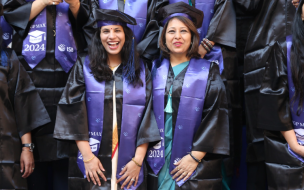However, by understanding the best ways to study for the GMAT Quantitative Reasoning section, and with plenty of practice, there’s no reason why you can’t ace those tricky GMAT math questions.
Doing so is important because business schools look at the different components of your total GMAT score—not just your score out of 805—and a good GMAT Quant score is strongly favored by most schools.
Here’s everything you need to know about the GMAT Quantitative Reasoning section in our GMAT Quant Guide:
How is the GMAT Quant scored?
The GMAT Quant section, along with the GMAT Verbal Reasoning section and GMAT Data Insights section, makes up your score out of 805. Quantitative scores range from 60 to 90.
Your GMAT Quantitative score is based on three factors: the number of questions you answer; whether your answers are correct; and the difficulty of the questions you answer correctly, which increases with each correct answer.
How long is the GMAT Quant section?
You have 45 minutes to complete 21 multiple-choice questions in the GMAT Quant section.
Are calculators allowed in the GMAT Quant?
Calculators are not allowed in the quant section of the GMAT so you’ll need to sharpen your mental math ability.
The GMAT is designed to test your mental math and problem-solving abilities. That’s why you can’t use a calculator. You shouldn’t need a calculator to solve problems, and the fact you can’t use a calculator is built into the design of the test.
Is GMAT math hard?
The underlying GMAT math questions in the Quant section are about high school-level difficulty. As an item-adaptive test, the difficulty of questions increases the more questions you answer correctly.
In thinking about the approach needed for this section, remember that your workings-out are not regarded. It is all about finding the correct answer in the shortest time possible. This means that the GMAT math syllabus is different and the way you solve problems will be different from the way you’d solve a similar problem in high school.
What types of questions come up in GMAT Quant?
The GMAT Quantitative Reasoning section only has Problem Solving question types.
GMAT Problem Solving
The format of Problem Solving questions is straightforward: a mathematical question, along with 5 multiple-choice answers. The alternatives given are part of the information you need to solve the problem.
In many cases you don’t need to solve the question per se, just to find the right answer by any means possible. The alternatives are not only great clues, but they also define the scope of the question and can allow you to use approximation, rounding up, or identifying patterns to solve questions.
In the GMAT, the alternatives are always in increasing or decreasing order. One example of a useful technique would be to ‘back solve’. For example, let’s say you are looking for the value of x. Why not insert the answer choice for C to see if it makes sense, or if the number should be bigger or smaller?
What kind of math is tested on the GMAT?
Math problems that come up on the GMAT Quant include:
Word problems – general algebra, buy and sell/profit, percentages, and interest,
Arithmetic/number properties – integers and non-integers, divisibility rules, even and odd numbers, prime numbers, lowest common denominator and greatest common divisor, perfect squares, Equations with integers, remainders, terminating and non-terminating decimals, rounding off and comparison between numbers.
Ratio and proportion- problems with mixtures, speed problems, and work rates.
Algebra – Powers and roots, linear equations, quadratic equations, simultaneous equations, functions, inequalities, absolute value
Statistics- averages, median, range, mode, and standard deviation
Sequences – general rules and arithmetic series.
Overlapping sets (Venn diagrams)
Probability rules and combinatorics
How to master your GMAT math

Follow five key steps to master the GMAT Quantitative Reasoning section and the key math questions:
1. Make sure you have a good foundation in math. You may need to revise some concepts.
2. Learn strategies like back-solving, plugging in numbers, and estimating. Through practice, you’ll get to know how to pick the most efficient strategy from your toolbox.
3. Don’t neglect the time pressure. Often, a timing problem is a symptom of using the wrong, long method to solve a problem
4. Keep an error log into your GMAT math practice, to reflect on which approach works for which problems, and to identify any weaknesses.
5. Read the question carefully. Very often in the GMAT you can get the right answer to the wrong question. Pay close attention to the wording.
For your GMAT math practice and to review multiple GMAT sample math questions check out our GMAT Sample Questions & Answers.

RECAPTHA :
c2
9e
5e
88







